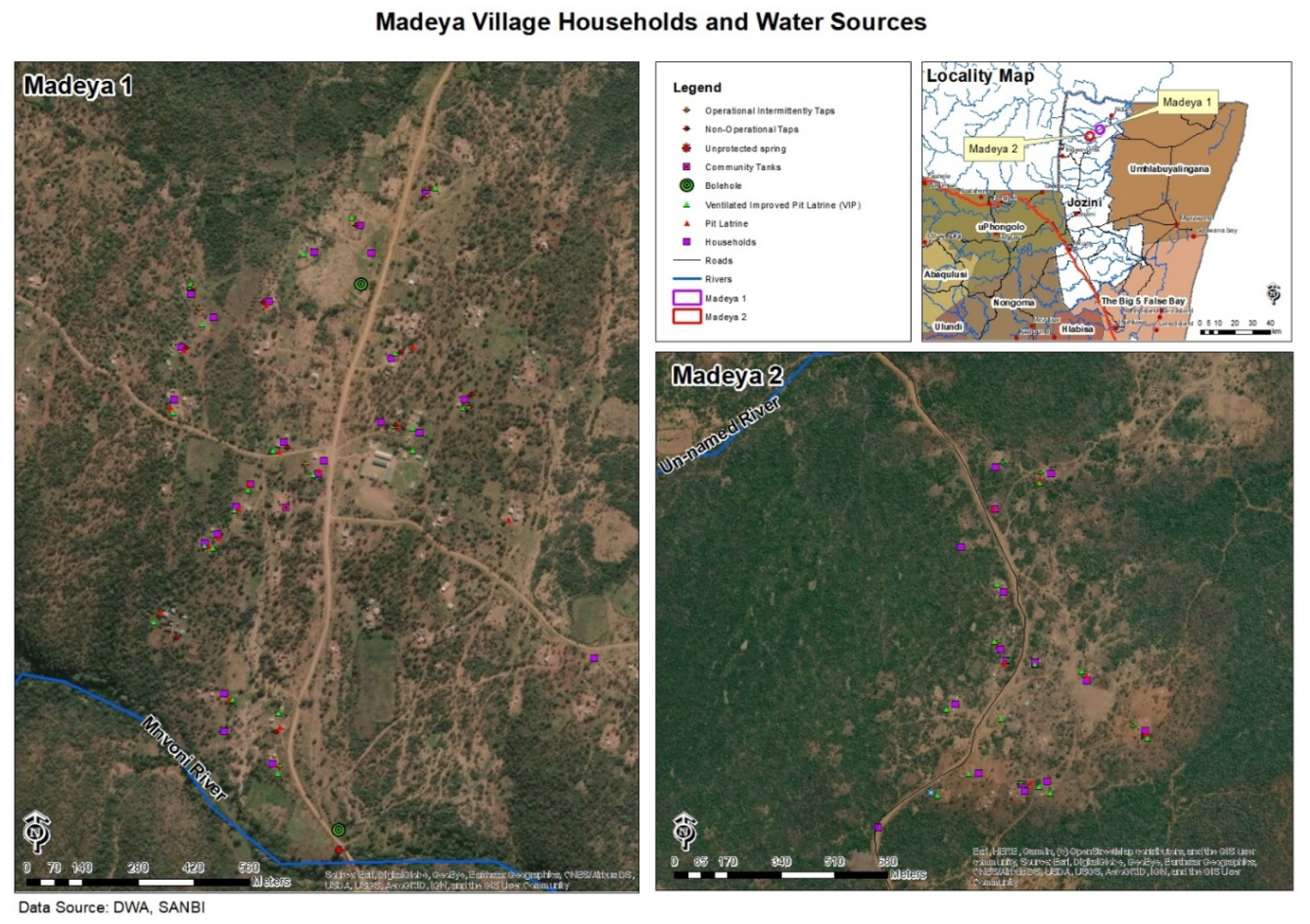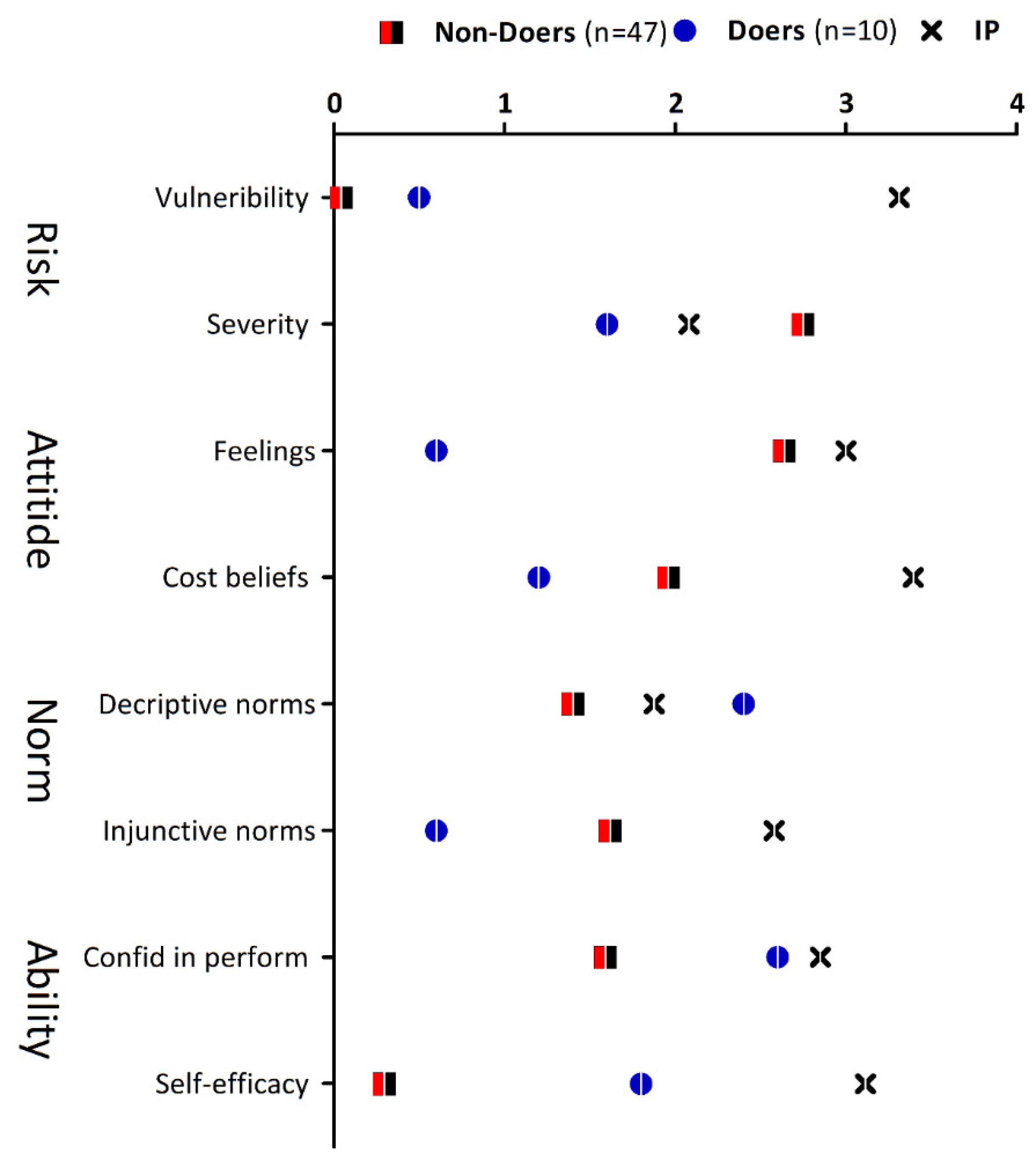Contextual and Psychosocial Factors Influencing the Use of Safe Water Sources: A Case of Madeya Village, uMkhanyakude District, South Africa
Abstract
1. Background
2. Materials and Methods
2.1. Study Area and Context
2.2. Data Collection Methods, Study Participants and Inclusion Criteria
2.3. Data Analysis
3. Results
Study Population
4. Discussion
5. Conclusions
Author Contributions
Funding
Acknowledgments
Conflicts of Interest
Abbreviations
| RANAS | Risk, Attitudes, Norms, Ability, Self-Regulation |
| BCT | Behavioural Change Technique |
| WASH | Water, Sanitation and Hygiene |
References
- UNICEF and WHO. Progress on Household Drinking Water, Sanitation and Hygiene 2000–2017: Special Focus on Inequalities; World Health Organization: Geneva, Switzerland, 2019. [Google Scholar]
- Prüss-Ustün, A.; Bartram, J.; Clasen, T.; Colford, J.M.; Cumming, O.; Curtis, V.; Bonjour, S.; Dangour, A.D.; France, J.D.; Fewtrell, L.; et al. Burden of disease from inadequate water, sanitation and hygiene in low- and middle-income settings: A retrospective analysis of data from 145 countries. Trop. Med. Int. Health 2014, 19, 894–905. [Google Scholar] [CrossRef]
- Vos, T.; Flaxman, A.D.; Naghavi, M.; Lozano, R.; Michaud, C.; Ezzati, M.; Shibuya, K.; Aboyans, V.; Abraharm, J.; Ackerman, I.; et al. Years lived with disability (YLDs) for 1160 sequelae of 289 diseases and injuries 1990–2010: A systematic analysis for the Global Burden of Disease Study 2010. Lancet 2012, 380, 2163–2196. [Google Scholar] [CrossRef]
- Steinmann, P.; Keiser, J.; Bos, R.; Tanner, M.; Utzinger, J. Schistosomiasis and water resources development: Systematic review, meta-analysis, and estimates of people at risk. Lancet Infect. Dis. 2006, 6, 411–425. [Google Scholar] [CrossRef]
- Mitra, A.; Mawson, A. Neglected tropical diseases: Epidemiology and global burden. Trop. Med. Infect. Dis. 2017, 2, 36. [Google Scholar] [CrossRef] [PubMed]
- World Health Organization. Schistosomiasis 2019. Available online: https://www.who.int/schistosomiasis/disease/en/ (accessed on 14 February 2020).
- Nwosu, D.; Anosike, J.; Nwoke, B.; Uwaezouke, J. Epidemiological assessment of vesical schistosomiasis in Bende local government area of Abia State, Nigeria. J. Appl. Sci. Environ. Manag. 2006, 10, 55–60. [Google Scholar] [CrossRef][Green Version]
- Mosler, H.-J. A systematic approach to behavior change interventions for the water and sanitation sector in developing countries: A conceptual model, a review, and a guideline. Int. J. Environ. Health Res. 2012, 22, 431–449. [Google Scholar] [CrossRef] [PubMed]
- Huber, A.C.; Mosler, H.-J. Determining behavioral factors for interventions to increase safe water consumption: A cross-sectional field study in rural Ethiopia. Int. J. Environ. Health Res. 2013, 23, 96–107. [Google Scholar] [CrossRef] [PubMed]
- Lilje, J.; Kessely, H.; Mosler, H.-J. Factors determining water treatment behavior for the prevention of cholera in Chad. Am. J. Trop. Med. Hyg. 2015, 93, 57–65. [Google Scholar] [CrossRef] [PubMed]
- Kabuyaya, M.; Chimbari, M.J.; Manyangadze, T.; Mukaratirwa, S. Schistosomiasis risk factors based on the infection status among school-going children in the Ndumo area, uMkhanyakude district, South Africa. S. Afr. J. Infect. Dis. 2017, 32, 67–72. [Google Scholar]
- Manyangadze, T.; Chimbari, M.J.; Gebreslasie, M.; Mukaratirwa, S. Risk factors and micro-geographical heterogeneity of Schistosoma haematobium in Ndumo area, uMkhanyakude district, KwaZulu-Natal, South Africa. Acta Trop. 2016, 159, 176–184. [Google Scholar] [CrossRef]
- Saathoff, E.; Olsen, A.; Magnussen, P.; Kvalsvig, J.D.; Becker, W.; Appleton, C.C. Patterns of Schistosoma haematobium infection, impact of praziquantel treatment and re-infection after treatment in a cohort of schoolchildren from rural KwaZulu-Natal/South Africa. BMC Infect. Dis. 2004, 4, 40. [Google Scholar] [CrossRef] [PubMed]
- Gamma, A.E.; Slekiene, J.; von Medeazza, G.; Asplund, F.; Cardoso, P.; Mosler, H.-J. Contextual and psychosocial factors predicting Ebola prevention behaviours using the RANAS approach to behaviour change in Guinea-Bissau. BMC Public Health 2017, 17, 446. [Google Scholar] [CrossRef] [PubMed]
- Mosler, H.; Contzen, N. Systematic Behavior Change in Water Sanitation and Hygiene A practical guide using the RANAS approach. Eawag 2016. Available online: https://www.toiletboard.org/media/29-Guideline_V1.0_final_25_08_2016_druck_3.pdf (accessed on 15 February 2020).
- Municipality, U.D. Umkhanyakude District Municipality Final IDP Document. 17 July 2019. Available online: http://www.ukdm.gov.za/images/documents/IDP/Umkhanyakude%20IDP%20Document%20for%202018_2019%20-%20Final%20Council.pdf (accessed on 15 February 2020).
- Pschorn-Strauss, E. Bt cotton in South Africa: The case of the Makhathini farmers. Seedling 2005, 2, 13–24. [Google Scholar]
- Sacolo-Gwebu, H.; Chimbari, M.; Kalinda, C. Prevalence and risk factors of schistosomiasis and soil-transmitted helminthiases among preschool aged children (1–5 years) in rural KwaZulu-Natal, South Africa: A cross-sectional study. Infect. Dis. Poverty 2019, 8, 47. [Google Scholar] [CrossRef]
- Ferligoj, A.; Mrvar, A. New Sampling Designs and the Quality of Data. Dev. Appl. Stat. 2003, 19, 205–217. [Google Scholar]
- Palla, F.; Le Bel, S.; Chavernac, D.; Cornélis, D. New technologies: Mobile data collection system implication for wildlife management in Central Africa, in Association for Tropical Biology and Conservation; CIRAD: Montpellier, France, 2016. [Google Scholar]
- Fishbein, M.; Ajzen, I. Predicting and Changing Behavior: The Reasoned Action Approach; Taylor & Francis Group: New York, YN, USA, 2011; pp. 6–82. [Google Scholar]
- Mosler, H.; Huber, A.; Inauen, J.; Tobias, R. A guideline to behavior change. Eawag 2013. Available online: https://www.eawag.ch/fileadmin/Domain1/Abteilungen/ess/schwerpunkte/ehpsy/behavioural_march_2013.pdf (accessed on 15 February 2020).
- Diouf, K.; Tabatabai, P.; Rudolph, J.; Marx, M. Diarrhoea prevalence in children under five years of age in rural Burundi: An assessment of social and behavioural factors at the household level. Glob. Health Action 2014, 7, 24895. [Google Scholar] [CrossRef]
- Boadi, K.O.; Kuitunen, M. Childhood diarrheal morbidity in the Accra Metropolitan Area, Ghana: Socio-economic, environmental and behavioral risk determinants. J. Health Popul. Dev. Ctries. 2005, 7, 1–13. [Google Scholar]
- Sacolo-Gwebu, H.; Kabuyaya, M.; Chimbari, M. Knowledge, attitudes and practices on schistosomiasis and soil-transmitted helminths among caregivers in Ingwavuma area in uMkhanyakude district, South Africa. BMC Infect. Dis. 2019, 19, 734. [Google Scholar] [CrossRef]
- Dreibelbis, R.; Kroeger, A.; Hossain, K.; Venkatesh, M.; Ram, P.K. Behavior change without behavior change communication: Nudging handwashing among primary school students in Bangladesh. Int. J. Environ. Res. Public Health 2016, 13, 129. [Google Scholar] [CrossRef]
- Devnarain, B.; Matthias, C.R. Poor access to water and sanitation: Consequences for girls at a rural school. Agenda 2011, 25, 27–34. [Google Scholar] [CrossRef]
- Utzinger, J.; Raso, G.; Brooker, S.; De Savigny, D.; Tanner, M.; Ørnbjerg, N.; Singer, B.H.; N’Goran, E.K. Schistosomiasis and neglected tropical diseases: Towards integrated and sustainable control and a word of caution. Parasitology 2009, 136, 1859–1874. [Google Scholar] [CrossRef] [PubMed]
- Asaolu, S.; Ofoezie, I. The role of health education and sanitation in the control of helminth infections. Acta Trop. 2003, 86, 283–294. [Google Scholar] [CrossRef]
- Singer, B.H.; de Castro, M.C. Bridges to sustainable tropical health. Proc. Natl. Acad. Sci. USA 2007, 104, 16038–16043. [Google Scholar] [CrossRef] [PubMed]
- Moser, S.; Mosler, H.-J. Differences in influence patterns between groups predicting the adoption of a solar disinfection technology for drinking water in Bolivia. Soc. Sci. Med. 2008, 67, 497–504. [Google Scholar] [CrossRef] [PubMed]
- Kelly, B.; Squiers, L.; Bann, C.; Stine, A.; Hansen, H.; Lynch, M. Perceptions and plans for prevention of Ebola: Results from a national survey. BMC Public Health 2015, 15, 1136. [Google Scholar] [CrossRef] [PubMed]
- Manyangadze, T.; Chimbari, M.J.; Gebreslasie, M.; Ceccato, P.; Mukaratirwa, S. Modelling the spatial and seasonal distribution of suitable habitats of schistosomiasis intermediate host snails using Maxent in Ndumo area, KwaZulu-Natal Province, South Africa. Parasites Vectors 2016, 9, 572. [Google Scholar] [CrossRef] [PubMed]
- Kalinda, C.; Chimbari, M.J.; Grant, W.E.; Wang, H.-H.; Odhiambo, J.N.; Mukaratirwa, S. Simulation of population dynamics of Bulinus globosus: Effects of environmental temperature on production of Schistosoma haematobium cercariae. PLoS Negl. Trop. Dis. 2018, 12, e0006651. [Google Scholar] [CrossRef]


| Percentage | ||
|---|---|---|
| Doer (n = 10) | Non-Doer (n = 47) | |
| Age | ||
| 43.70 ± 16.51 | 35.85 ± 12.22 | |
| Marital status | ||
| Married | 10 | 19.15 |
| Divorced | 0 | 4.26 |
| Single | 30 | 55.32 |
| Widowed | 20 | 2.13 |
| Cohabiting | 40 | 19.15 |
| Highest level of school completed | ||
| No school completed | 40 | 19.15 |
| Primary school | 30 | 29.79 |
| Secondary school | 30 | 44.63 |
| College level | 0 | 2.13 |
| University | 0 | 4.26 |
| Occupation | ||
| Student | 0 | 4.26 |
| Self-employed | 10 | 10.65 |
| Employed by Government | 0 | 2.13 |
| Employed by private company | 0 | 4.26 |
| Unemployed | 90 | 74.47 |
| Retired | 0 | 4.26 |
| Type of dwelling | ||
| Mainly traditional mud block with thatch | 10 | 17.02 |
| Mainly traditional mud block with corrugated iron | 30 | 31.91 |
| Mud plastered with cement | 0 | 21.28 |
| Concrete or cinder block | 30 | 21.28 |
| Modern brick house | 30 | 4.28 |
| Temporary structure | 0 | 0 |
| Other | 0 | 4.28 |
| Primary Source of Water | n | % |
|---|---|---|
| Tap | 6 | 10.53 |
| Pump | 4 | 7.02 |
| Surface | 44 | 77.19 |
| Tanker | 2 | 3.51 |
| Not classified | 1 | 1.75 |
| Total | 57 | 100 |
© 2020 by the authors. Licensee MDPI, Basel, Switzerland. This article is an open access article distributed under the terms and conditions of the Creative Commons Attribution (CC BY) license (http://creativecommons.org/licenses/by/4.0/).
Share and Cite
Mulopo, C.; Kalinda, C.; Chimbari, M.J. Contextual and Psychosocial Factors Influencing the Use of Safe Water Sources: A Case of Madeya Village, uMkhanyakude District, South Africa. Int. J. Environ. Res. Public Health 2020, 17, 1349. https://doi.org/10.3390/ijerph17041349
Mulopo C, Kalinda C, Chimbari MJ. Contextual and Psychosocial Factors Influencing the Use of Safe Water Sources: A Case of Madeya Village, uMkhanyakude District, South Africa. International Journal of Environmental Research and Public Health. 2020; 17(4):1349. https://doi.org/10.3390/ijerph17041349
Chicago/Turabian StyleMulopo, Chanelle, Chester Kalinda, and Moses J. Chimbari. 2020. "Contextual and Psychosocial Factors Influencing the Use of Safe Water Sources: A Case of Madeya Village, uMkhanyakude District, South Africa" International Journal of Environmental Research and Public Health 17, no. 4: 1349. https://doi.org/10.3390/ijerph17041349
APA StyleMulopo, C., Kalinda, C., & Chimbari, M. J. (2020). Contextual and Psychosocial Factors Influencing the Use of Safe Water Sources: A Case of Madeya Village, uMkhanyakude District, South Africa. International Journal of Environmental Research and Public Health, 17(4), 1349. https://doi.org/10.3390/ijerph17041349





